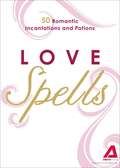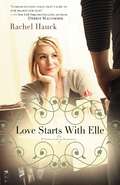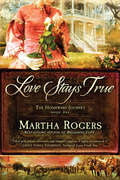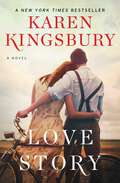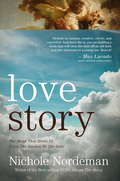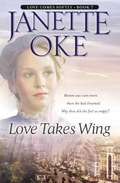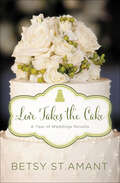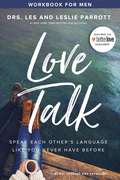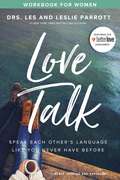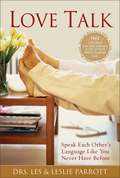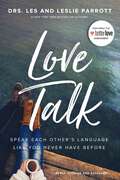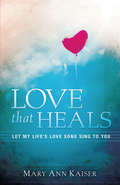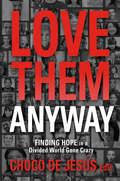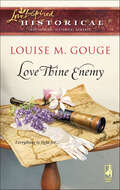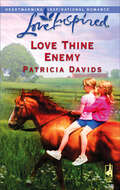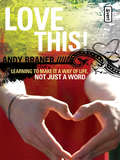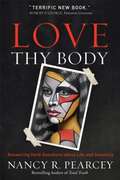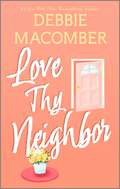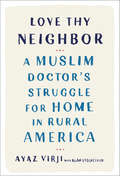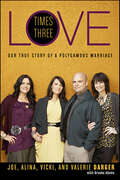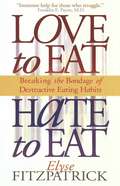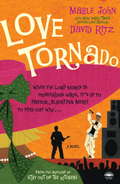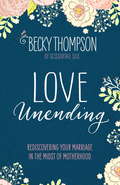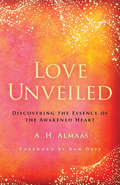- Table View
- List View
Love Spells: 50 Romantic Incantations and Potions (Spells)
by Adams MediaA little love magick can go a long way. Whether you’re looking to attract a new mate, get over an old ex, or get things going in the bedroom, Love Spells has the potions and incantations you need to satisfy your desires. Easy and effective, they’ll add a little romance to your life (or a little spice between the sheets).
Love Starts With Elle: Sweet Caroline, Love Starts With Elle, Dining With Joy (A Lowcountry Romance #2)
by Rachel HauckElle's living the dream, but whose dream is it?Elle Garvy loves her life in Beaufort, South Carolina, spending summer days on the sand bar and enjoying coastal bonfires and dinners with friends. She&’s found her stride professionally as the owner of a successful art gallery, and she&’s found love with handsome, confident Jeremiah Franklin. Life is good.Then Jeremiah accepts a large pastorate in a different state, and Elle turns her life upside down to go with him. When Jeremiah has a change of heart, Elle is hurt and her faith is shaken.New York lawyer and recent widower Heath McCord imagines the low country cottage he&’s rented for the summer is the balm his grieving heart needs. That and time to connect with his little girl. He&’s unprepared for his beautiful landlord, Elle, and the love her friendship awakens.But God has new blessings in store for these two grieving hearts. Can Elle trust so soon after losing Jeremiah? Can Heath release the memory of his wife and fully love again?
Love Stays True (The Homeward Journey #1)
by Martha RogersCan Sallie and Manfred overcome the distance that the war has put between them and find love? In April 1865, the day following the surrender at Appomattox, Manfred McDaniel Whiteman and his brother, Edward, are released in an exchange of prisoners. They are given a few provisions, and they begin a long journey to their home in Bayou Sara, Louisiana. At home Sallie Dyer is waiting word of her beloved Manfred. Though just a young girl when Manfred left, Sallie has grown into a caring young woman who is determined to wait for her love--despite her father’s worries that she is wasting her life on someone who may never come home. On their journey Manfred and his brother encounter storms and thieves and are even thrown in jail. Will he make the journey home before someone else claims Sallie’s hand?
Love Story: A Novel (The Baxter Family #Bk. 1)
by Karen KingsburyFrom #1 New York Times bestselling author Karen Kingsbury comes a romantic story featuring everyone&’s favorite family—the Baxters—as it reveals how John and Elizabeth first fell in love.From the day they met, John and Elizabeth were destined to fall in love. Their whirlwind romance started when they were young college students and lasted nearly thirty years. So when John Baxter is asked to relive his long-ago love story with Elizabeth for his grandson Cole&’s heritage project, he&’s not sure he can do it. The sadness might simply be too great. But he agrees and allows his heart and soul to go places they haven&’t gone in decades. Back to the breathless first moments, but also to the secret heartbreak that brought John and Elizabeth together. At the same time, Baxter family friend Cody Coleman is working through the breakup of his complicated relationship with Andi Ellison. He is determined to move on when a chance sighting changes his plans—and heart. Can Cody convince Andi to give their love another try, or is it time for them to say goodbye for good? As school comes to an end, Cole presents his report on the love story between his grandparents John and Elizabeth Baxter. It is a tale that touches the hearts of the entire family, and one that causes Cole to better understand his own beginning. Whether you&’re meeting the Baxter family for the first time or finding them all over again, Love Story will stir your heart and remind you of the generational impact of love and the eternal bond of family.
Love Story: The Hand that Holds Us From the Garden to the Gate
by Nichole NordemanBased on the #1-selling Christian album The Story (EMI/WOW), lyricist and Grammy- nominated artist Nichole Nordeman helps readers embrace God's relentless, loving pursuit of the most weak and sinful among us from the beginning of time.Love Story is an exquisite narrative that exposes the emotional and human underside of major biblical events, including Adam and Eve's dramatic fall in the Garden of Eden, Sarah and Abraham's struggle to have a child, Mary's surprise at being pregnant with Jesus, Paul's trauma on the road to Damascus, and concludes with a triumphant picture of the second coming of Christ. This book is a dramatic connecting point for all readers, inspiring them to grasp the poignant nature of God's immense, all-consuming love
Love Takes Wing (Love Comes Softly #7)
by Janette OkeBelinda Davis is restless. As her friends get married and have children of their own, she wonders what God has in store for her. Her life as a nurse seems dull and routine. She craves excitement and adventure. When she meets an elderly woman who needs nursing care, Belinda jumps at the invitation to travel to Boston, a large, vibrant city so unlike the little prairie town where she was raised. Opportunities for books, theatre and the luxuries of life provide excitement ... for a time. But in spite of financial security, countless new experiences, and even some romance, Belinda finds herself restless, lonely, and empty inside.
Love Takes the Cake: A September Wedding Story (Year of Weddings Novellas)
by Betsy St. AmantThey&’ve helped orchestrate the perfect day for countless couples. Now twelve new couples will find themselves in the wedding spotlight in the second Year of Weddings novella collection.She&’s known for her delicious cakes, but there&’s no recipe for dealing with the new man in her life.Charlotte Cantrell is always the baker; never the bride. Clients come from near and far for her renowned wedding cakes. And while the wedding scene is Charlotte&’s place to shine, her own love life is more dullthan ever.When Will, a regular at Charlotte&’s bakery, catches her attention, she can only hope that he is the reliable man this single mother has always hoped to find. The problem is that he&’s regularly stopping in to buy cookies for another girl. But when Charlotte is hired to bake a host of wedding goodies for a difficult bride and finds out Will is the best man, she has the perfect opportunity to get to know him better—and find out how serious Will is about this other girl in his life.
Love Talk Workbook for Men: Speak Each Other's Language Like You Never Have Before
by Les And ParrottWe set off to crack the code for meaningful conversation…a plan that would move our communication from good to great. And we found it. A deep and simple plan for everything a loving conversation has to offer. We call it Love Talk. —Drs. Les and Leslie ParrotThis men’s workbook will help you personalize the concepts you encounter in the Parrotts’ book Love Talk and put them to work in your relationships. Inside, you’ll find exercises, assessments, self-tests, tips, applications…all the tools and guidance you need toIdentify your personal communication styleUnderstand how it interacts with that of your partnerTalk your way to a healthier, stronger relationshipLove Talk is like no other communication book you’ve ever read. The fruit of years of research by two foremost relationship experts (who also happen to be husband and wife), this book forges a new path to the heart of loving conversation. You’ll begin by identifying your security need and determining your personal communication style. Then you’ll put together everything you discover to learn how the two of you can speak each other’s language like never before.This very day, you can begin an adventure in communication that will draw the two of you closer, and closer, and close…consistently, in a way that creates the depth and connection you long for in your relationship.
Love Talk Workbook for Women: Speak Each Other's Language Like You Never Have Before
by Les And ParrottWe set off to crack the code for meaningful conversation…a plan that would move our communication from good to great. And we found it. A deep and simple plan for everything a loving conversation has to offer. We call it Love Talk. —Drs. Les and Leslie ParrotThis women’s workbook will help you personalize the concepts you encounter in the Parrotts’ book Love Talk and put them to work in your relationships. Inside, you’ll find exercises, assessments, self-tests, tips, applications…all the tools and guidance you need toIdentify your personal communication styleUnderstand how it interacts with that of your partnerTalk your way to a healthier, stronger relationshipLove Talk is like no other communication book you’ve ever read. The fruit of years of research by two foremost relationship experts (who also happen to be husband and wife), this book forges a new path to the heart of loving conversation. You’ll begin by identifying your security need and determining your personal communication style. Then you’ll put together everything you discover to learn how the two of you can speak each other’s language like never before.This very day, you can begin an adventure in communication that will draw the two of you closer, and closer, and close…consistently, in a way that creates the depth and connection you long for in your relationship.
Love Talk: Speak Each Other's Language Like You Never Have Before
by Parrott LesA breakthrough discovery in communication for transforming love relationships Over and over couples consistently name “improved communication” as the greatest need in their relationships. Love Talk—by acclaimed relationship experts Drs. Les and Leslie Parrott—is a deep yet simple plan full of new insights that will revolutionize communication in love relationships. The first steps to improving this single most important factor in any marriage or love relationship are to identify your fear factors and determine your personal communication styles, and then learn how the two of you can best interact. In this no-nonsense book, “psychobabble” is translated into easy-to-understand language that clearly teaches you what you need to do—and not do—for speaking each other’s language like you never have before. Love Talk includes: • The Secret to Emotional Connection • Charts and sample conversations • The most important conversation you’ll ever have • A short course on Communication 101 • Appendix on Practical Help for the “Silent Partner”
Love Talk: Speak Each Other's Language Like You Never Have Before
by Les And ParrottLove Talk is like no other communication book you’ve ever read. The fruit of years of research by two foremost relationship experts (who also happen to be husband and wife), this book forges a new path to the heart of loving conversation. You’ll begin by identifying your security need and determining your personal communication style. Then you’ll put together everything you discover to learn how the two of you can speak each other’s language like never before.This very day, you can begin an adventure in communication that will draw the two of you closer, and closer, and closer…consistently, in a way that creates the depth and connection you long for in your relationship.Love Talk includes:The all-new Deep Love AssessmentThe secret to emotional connectionWhen not to talkA Communications 101 primerPractical help for the “silent partner”Designed for use with the companion men’s and women’s Love Talk workbooks (sold separately).
Love That Heals: Let My Life's Love Song Sing to You
by Mary Ann KaiserFINDING HOPE AND HEALING Whether it’s broken bodies or broken relationships, the answer is the same--there’s healing and wholeness in the amazing love of Jesus. Having experienced the transforming hand of God in her own life, Mary Ann Kaiser now travels widely sharing her remarkable story and introducing others to the same restoring power, from Brazil to Haiti and across the United States. Once struggling in a troubled marriage, contemplating suicide, and crippled by sickness that doctors said would end in death, today she enjoys full health and irrepressible joy. Recounting how she and her husband, Michael, found unexpected new life and purpose, Mary Ann offers hope and encouragement to all who have ever despaired that things could ever get better. Forgiveness and faith are key, she explains, but there is no formula: God simply meets us where we are, and brings us to “a place of wonderful love.” Join her there in this inspiring book.
Love That Lasts: How We Discovered God’s Better Way for Love, Dating, Marriage, and Sex
by Jefferson Bethke Alyssa BethkeIn Love That Lasts, New York Times bestselling author of Jesus > Religion Jefferson Bethke and his wife, Alyssa, expose the distorted views of love that permeate our culture and damage our hearts, minds, and souls.Drawing from Jeff’s “prodigal son” personal history and from Alyssa’s “True Love Waits” experience, the Bethkes point to a third and better way. Blending personal storytelling with biblical teaching, they offer readers an inspiring, realistic vision of love, dating, marriage, and sex.Young people today enter adulthood with expectations of blissful dating followed by a romantic, fulfilling marriage only to discover they’ve been duped. They learned about love and sexuality from social media, their friends, Disney fairy tales, pornography, or even their own rocky past, and they have no idea what healthy, lifelong love is supposed to be like. The results are often disastrous, with this generation becoming one of the most relationally sick, sexually addicted, and divorce ridden in history.Looking to God’s design while drawing lessons from their own successes and failures, the Bethkes explode the fictions and falsehoods of our current moment. One by one, they peel back the lies, such as the belief that every person has only one soul mate, that marriage will complete you, or that pornography and hook-ups are harmless.
Love Them Anyway: Finding Hope in a Divided World Gone Crazy
by Choco De JesúsLove breaks through defenses and destroys walls that divide us. Love demands more of you and me than we often want to give. It&’s easy to love a lovely person, but what about...them? What about that stereotype, that race, that person or group of people in a political, cultural, or socioeconomic class who don&’t behave like you, don&’t believe like you, and if you are honest...make you uncomfortable? What is love in this context? We read that Jesus broke boundaries to love the people that many detested. His love was transformative because His love saw past disagreement, indifference, and offense. Loving them? Like this? That&’s hard. If you consider yourself a Christian, then love should be your primary characteristic. But it seems that division defines us in our society where rage and anger abound. Today, many people see Christians as angry followers of God who are more interested in winning political arguments than loving people. If we say we follow Jesus but are not loving like Him, then what&’s the point? There is a better way. Using the incredible story of how Pastor Choco chose to &“love them anyway&” to transform the crime-ridden community of Humboldt Park in Chicago, Love Them Anyway will inspire you to love in a way you never have. This book will pave a compelling path for you to both express and experience a truly transformative love on a deep level. It will tap into your deepest desires, expose your hesitations, connect you deeper with God&’s love, and help you take bold steps to love the people around you—and your love will change lives. When you learn to Love Them Anyway, your passion will be redirected, your purpose will be refined, and you will see God use you in ways you could never have imagined. Love is hard. It&’s not convenient, and it&’s not always safe. But love is beautiful. Love is contagious. It breaks through defenses and destroys walls that divide us. Love is the answer. So, love them anyway.Redirect your passion, refine your purpose, and see God use you in ways you never imagined.
Love Thine Enemy
by Louise M. GougeThe tropics of colonial Florida are far removed from America's Revolution. Still, Rachel Folger's loyalties remain with Boston's patriots. Handsome plantation owner Frederick Moberly's faithfulness to the Crown is as certain as his admiration for Rachel-but for the sake of harmony, he'll keep his sympathies hidden. After all, the war is too far distant to truly touch them...isn't it?A betrayal of Rachel's trust divides the pair, leaving Frederick to question the true meaning of faith in God and in country. Inspired by Rachel to see life, liberty and love through His eyes, Frederick must harness his faith and courage to claim the woman he loves before war tears them apart.
Love Thine Enemy
by Patricia DavidsFrom US TODAY Bestselling Author, Patricia DavidsA promise to her sister sent rising ballet star Cheryl Steele temporarily back to the hometown she had fled years ago in disgrace. Then an unexpected snowstorm and an injured foot soon landed her in the home of Sam Hardin. Sam's two little girls wrapped themselves around her heart...while they schemed to make Cheryl not a guest or temporary nanny but their new mom.But staying with the Hardin family made Cheryl uneasy. She feared confessing past secrets to Sam, and she had even greater fear of the present. Because the more Cheryl stayed with Sam, the more it all felt so right....\From Love Inspired: Uplifting stories of faith, forgiveness and hope.Discover the North Country Amish miniseries by Patricia Davids:Book 1: Shelter from the StormBook 2: The Amish Teacher's DilemmaBook 3: A Haven for ChristmasBook 4: Someone to TrustBook 5: An Amish Mother for His TwinsBook 6: Mistaken for His Amish BrideBook 7: Christmas on His Doorstep
Love This! Learning To Make It A Way Of Life, Not Just A Word
by Andy BranerLOVE YOUR NEIGHBOR. . . AND THEN SOME When Jesus tells us to love our neighbors, he doesn't just mean the strange guy across the street (you know the one). He's talking about our neighbors on this planet-the people we see every day. . . and even those we don
Love Thy Body: Answering Hard Questions About Life And Sexuality
by Nancy R. Pearcey<P><P>Why the call to Love Thy Body? To counter a pervasive hostility toward the body and biology that drives today's headline stories: Transgenderism: Activists detach gender from biology. Kids down to kindergarten are being taught their bodies are irrelevant. Is this affirming--or does it demean the body? Homosexuality: Advocates disconnect sexuality from biological identity. Is this liberating--or does it denigrate biology? Abortion: Supporters deny the fetus is a person, though it is biologically human. Does this mean equality for women--or does it threaten the intrinsic value of all humans? Euthanasia: Those who lack certain cognitive abilities are said to be no longer persons. Is this compassionate--or does it ultimately put everyone at risk? <P><P> In Love Thy Body, bestselling author Nancy Pearcey goes beyond politically correct slogans with a riveting exposé of the dehumanizing worldview that shapes current watershed moral issues. Pearcey then turns the tables on media boilerplate that misportrays Christianity as harsh or hateful. A former agnostic, she makes a surprising and persuasive case that Christianity is holistic, sustaining the dignity of the body and biology. Throughout she entrances readers with compassionate stories of people wrestling with hard questions in their own lives--their pain, their struggles, their triumphs.
Love Thy Neighbor
by Debbie MacomberFrom #1 New York Times bestselling author Debbie Macomber comes a classic story of love found where it's least expected...right next door!For weeks, Lesley Brown had been counting down the days, curious and excited about the arrival of her new neighbor. With their duplex being the only house for miles, she couldn&’t help but hope the new tenant would be a friend. But when she met Cole Daniels, hope turned into something far more complicated.Cole was everything she didn&’t expect—sharp-tongued, standoffish, infuriatingly cryptic. And yet, there was something about him that Lesley couldn&’t ignore. Maybe it was the way he came to her rescue, then frustratingly shut her out again. Or maybe it was the secrets he so carefully guarded, secrets that practically begged to be unraveled.Was Cole running from something, or simply keeping the world—and Lesley—at arm&’s length? As their lives became increasingly tangled, she began to wonder…would the truth bring them closer, or drive an unsurmountable wedge between them?Also by Debbie Macomber:HEARTSONGA GIRL LIKE JANETUNDERCOVER DREAMER
Love Thy Neighbor: A Muslim Doctor's Struggle for Home in Rural America
by Alan Eisenstock Ayaz VirjiA powerful true story about a Muslim doctor's service to small-town America and the hope of overcoming our country's climate of hostility and fear.In 2013, Ayaz Virji left a comfortable job at an East Coast hospital and moved to a town of 1,400 in Minnesota, feeling called to address the shortage of doctors in rural America. But in 2016, this decision was tested when the reliably blue, working-class county swung for Donald Trump. Virji watched in horror as his children faced anti-Muslim remarks at school and some of his most loyal patients began questioning whether he belonged in the community. Virji wanted out. But in 2017, just as he was lining up a job in Dubai, a local pastor invited him to speak at her church and address misconceptions about what Muslims practice and believe. That invitation has grown into a well-attended lecture series that has changed hearts and minds across the state, while giving Virji a new vocation that he never would have expected. In Love Thy Neighbor, Virji relates this story in a gripping, unforgettable narrative that shows the human consequences of our toxic politics, the power of faith and personal conviction, and the potential for a renewal of understanding in America's heartland.
Love Times Three: Our True Story of a Polygamous Marriage
by Joe Darger Vicki Darger Valerie Darger Alina DargerFrom a familythat inspired Big Love’s story of Bill Henricksonand his three wives, this first-ever memoir of a polygamous family captures theextraordinary workings of a unique family dynamic, and argues forthe acceptance of plural marriage as an alternative lifestyle. Readers ofCarolyn Jessop’s Escape, Elissa Wall’s StolenInnocence,and James McGreevey’s Confession,as well as fans of shows like Big Love and Sister Wives, will beenthralled by the first groundbreaking book in praise of polygamy.
Love To Eat, Hate To Eat
by Elyse FitzpatrickNot just another diet book, Elyse Fitzpatrick helps women make realistic, practical steps toward proper eating, health, and emotional balance. With biblical guidelines for victory, this book is ideal for Christian women who want to fully yield this area of their lives to the Lord.
Love Tornado
by David Ritz Mable JohnPastor Albertina Merci, the former blues singer turned minister, juggles rap, romance, family, and faith in the third book in this delightful series. The unexpected arrival of fifteen-year-old rapper J Love hits Pastor Merci with the force of a whirlwind. When J’s mother is killed in a tragic bus accident, Albertina is named his legal guardian. The situation quickly complicates her budding romance with Mario, the owner of a thriving L. A. café. As Albertina struggles to keep things on an even keel, J embarks on a dangerous journey of his own. Seduced by Bishop Henry Gold’s daughter Damitra, J abandons his career as a gospel rapper and joins the flashy, materialistic world of gangsta rap. Pastor Merci must draw on every ounce of faith she has to bring everyone’s voyage to a happy ending.
Love Unending: Rediscovering Your Marriage in the Midst of Motherhood
by Becky ThompsonHow can I remember how to be a wife when it takes all I’ve got to be a momma?Since becoming a mom, do you ever feel like your marriage no longer receives the attention it needs to thrive? Do you ever wonder how you’re supposed to re-center your heart on your husband when you are so busy with everything else? Those feelings we experienced in the first days of love and marriage often become buried beneath hurried life, active children, and mountains of bills and laundry. Maybe you’ve questioned and perhaps even worried if you’ll ever again experience love as you did in the beginning—that newness of what it meant to be fully caught up in one another. But what if you could rekindle that fresh sort of love? What if there was a secret to love unending? For the next twenty-one days, journey with Becky Thompson to remember what life was like when you first fell in love with your husband. Each daily challenge, reflection, and prayer will refocus your attention, re-center your heart, reignite the romance, and help you rediscover your marriage in the midst of motherhood. Take the Love Unending 21-day challenge and discover the best way forward is to look back at the beginning.From the Trade Paperback edition.
Love Unveiled: Discovering the Essence of the Awakened Heart
by A. H. AlmaasA passionate and deep exploration of how love is essential to our spiritual growth and development, from beloved author and teacher A. H. Almaas.Love is a universal energy--and a primary force that powers our movement toward spiritual illumination. All the ways we need love are simply reflections of our need for spiritual growth. In The Power of Spiritual Love, A. H. Almaas explores three dimensions of love: appreciative love--the true liking of somebody or something; merging or connecting love--a force that melts away separateness; and passionate, ecstatic love--capable of consuming us from inside. In their own way, each reveals the beauty and exquisiteness of our spiritual heart, which is the heart of the divine.However, the path of spiritual love is not without challenges. Almaas explores the barriers that tend to block our experience of loving awakening and provides experiential exercises throughout the book to help readers along their path. The exercises focus on the obstacles or misunderstandings that commonly arise for each quality or dimension of love. Presented in the form of writing or monologuing prompts, readers can work independently or in small groups to confront the emotional obstacles on their spiritual path. Regardless of where you are on your path, The Power of Spiritual Love will help you explore love in three essential dimensions and gain a deeper connection to yourself.
